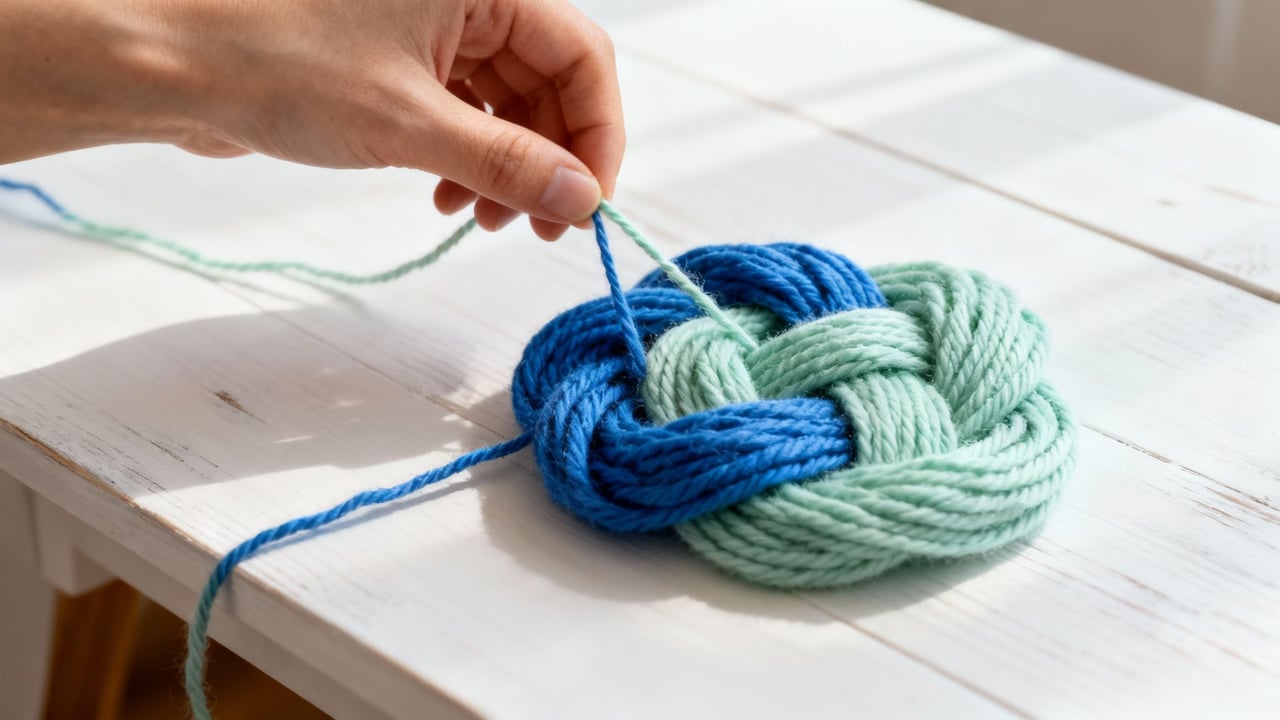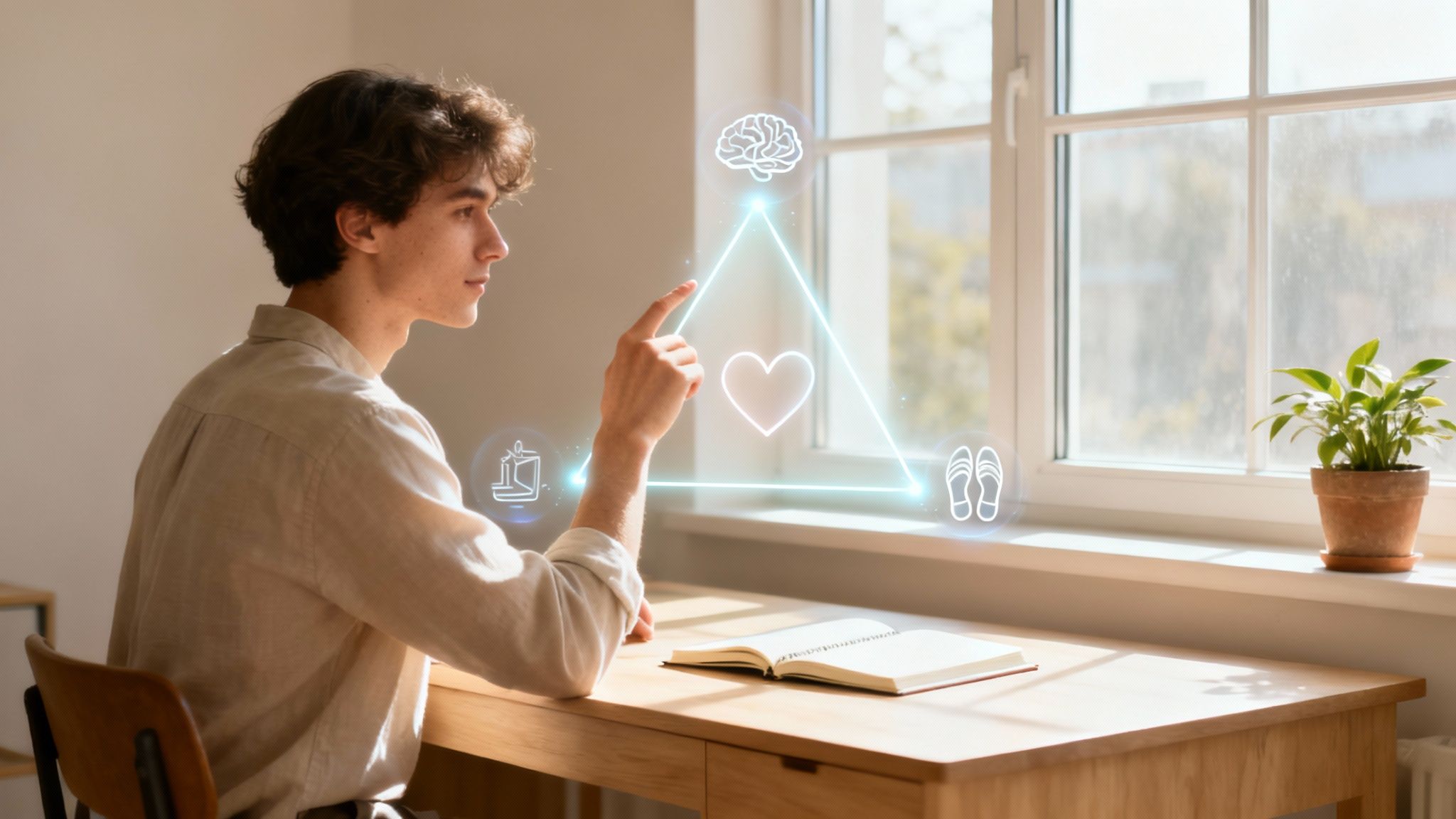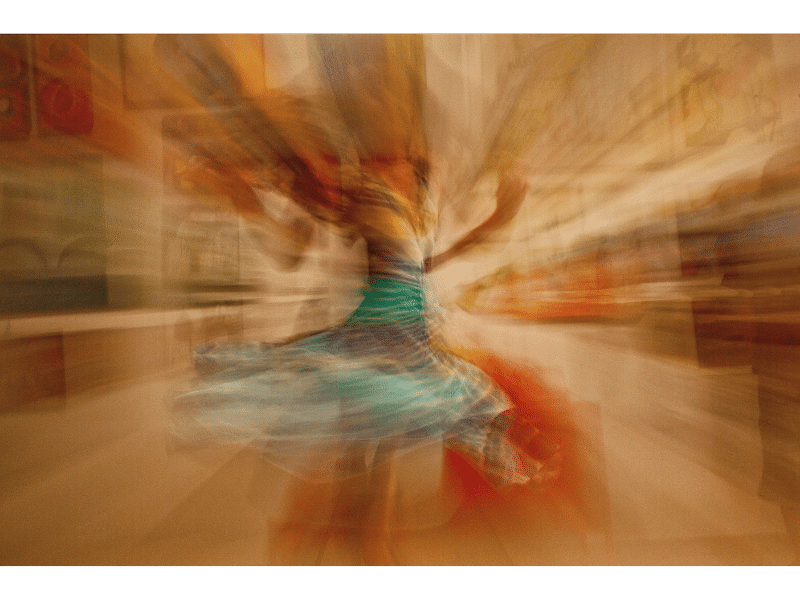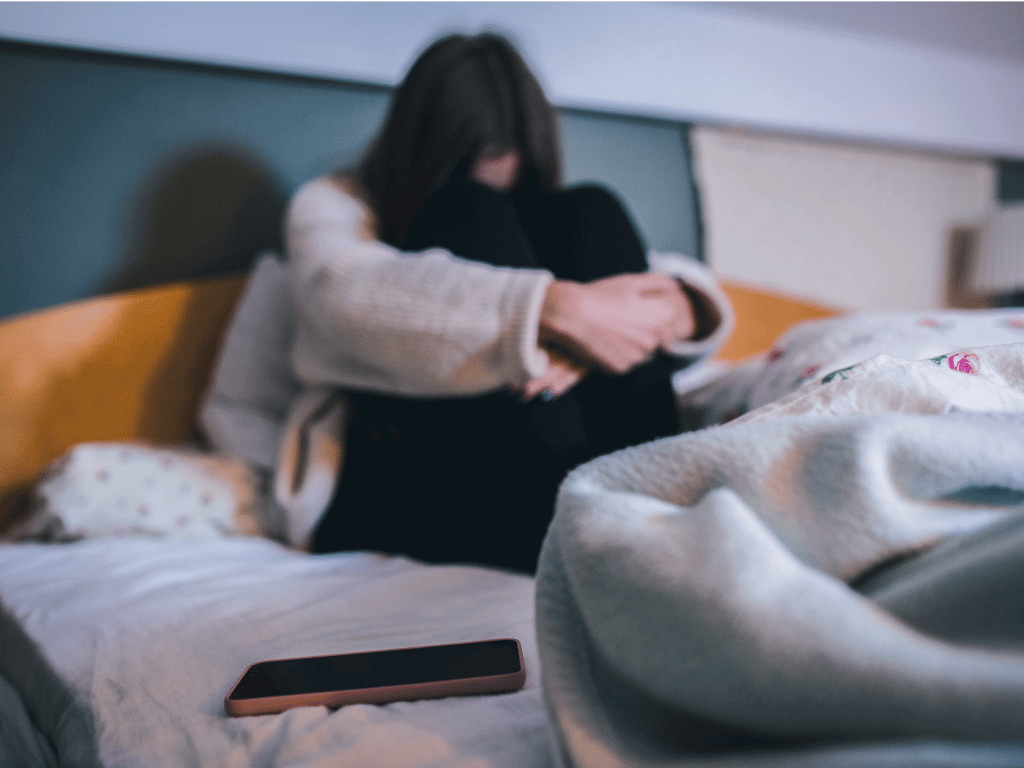If your brain feels like a web browser with way too many tabs open—some racing with scattered thoughts, others stuck on a loop of worry—you're not alone. The link between ADHD and anxiety is incredibly common. In fact, research suggests that up to 50% of adults with ADHD also have an anxiety disorder.
For many people, they feel like two tangled threads. It can be almost impossible to see where one begins and the other ends.
The Overwhelming Overlap of ADHD and Anxiety
Living at the intersection of ADHD and anxiety can feel like being pulled in two directions at once. One part of your brain is chasing novelty and struggling to focus, while another is totally consumed by "what-if" scenarios and a nagging sense of dread. This constant internal tug-of-war isn't just in your head; it's a very real and exhausting experience that many people with ADHD recognize.

This guide is here to help you gently untangle those threads. Our goal is to make you feel seen and understood, replacing that swirl of confusion with clarity and empowerment. We'll dig into why these two conditions so often show up together and introduce practical, science-backed tools to help you manage the mental static.
Making Sense of the Chaos
The first step is simply recognizing that what you're feeling is valid. The day-to-day challenges of ADHD—like missing deadlines, losing the plot in conversations, or battling with organization—naturally create a fertile ground for anxiety to take root. For many, it’s less of a coincidence and more of a cause-and-effect situation.
🔬 Scientific Takeaway: For many, anxiety isn't a separate, random problem. Instead, it can be a logical emotional response to the very real difficulties and frustrations that come with having an ADHD brain.
Getting your head around this dynamic is a game-changer because it shifts the focus from self-blame to self-compassion. You're not "broken" or "failing"; you're dealing with complex brain wiring that requires a different set of tools. Learning about the deeper connections between these conditions can be a powerful first step, and you can learn more about how ADHD can cause anxiety and other mood disorders in our detailed article.
Throughout this journey, we'll explore strategies that address both the root causes and the symptoms. We’ll also touch on how structured support, like the programs in the Inflow app, can help you build the skills to manage this complex relationship. By translating proven therapeutic techniques into daily, manageable steps, you can start to find a calmer, more focused path forward. Have you noticed this pattern in your own life?
Why Your Brain Feels Pulled in Two Directions
If you live with both ADHD and anxiety, you’ve probably asked yourself why they seem to show up together so often. It’s a good question, and the answer has nothing to do with personal weakness or a lack of willpower. The connection is hardwired into your brain's biology and shaped by the psychological stress of navigating a world not always built for the way you think.
Understanding this is empowering. It helps you switch the script from self-blame ("What's wrong with me?") to genuine self-awareness ("Okay, how does my brain work?"). Let's break down the main reasons your brain might feel like it's being pulled in two different, exhausting directions.
The Neurological Connection
On a fundamental level, it starts with brain chemistry. Think of your brain as a massive, complex electrical grid. For signals to get where they need to go, it relies on chemical messengers called neurotransmitters to bridge the gaps.
One of the star players in the ADHD world is dopamine. Dopamine is the chemical that regulates focus, motivation, and your sense of reward. In an ADHD brain, the dopamine system often functions differently, which can make it hard to stay locked in on tasks that aren't immediately interesting.
But here’s the twist: dopamine doesn’t just handle focus. It’s also a key player in regulating mood and emotional responses. When that system is out of whack, it can make you more vulnerable to feelings of stress and worry, creating a biological setup for anxiety. It’s like the same faulty wiring that scatters your focus is also hooked up to your emotional thermostat.
The Psychological Fallout
Beyond your brain’s wiring, there’s the day-to-day reality of living with ADHD. Imagine trying to build a house, but your blueprints are smudged and incomplete. You’d probably forget important steps, mismeasure materials, and feel like you’re constantly falling behind. The stress would be off the charts.
That’s a pretty good analogy for living with unmanaged ADHD. The daily friction of executive dysfunction—forgetting appointments, blowing past deadlines, losing the thread of conversations—creates a constant state of low-grade chaos. This isn't just an inconvenience; it's the perfect breeding ground for anxiety.
💡 Insight: In this context, anxiety often becomes a logical—if painful—coping mechanism. It’s your brain’s attempt to stay one step ahead of the next potential mistake. You worry because you've learned from painful experience that letting your guard down can lead to very real consequences.
This isn’t just a theory; it’s a well-documented pattern. Epidemiological studies have found a huge overlap, with one showing that 47% of adults diagnosed with ADHD also have a co-occurring anxiety disorder. Research like this highlights that when both conditions are present, the symptoms tend to be more severe. You can dig deeper into these findings on ADHD and anxiety comorbidity to see just how intertwined they are.
A Shared Genetic Blueprint
The third piece of the puzzle is in our genes. Research increasingly suggests that both ADHD and anxiety disorders have a strong genetic component and tend to run in families. If you have a family history of one, your chances of having the other may increase.
This doesn't mean your genes seal your fate, but it does point to a shared biological vulnerability. It’s like having a genetic predisposition for sensitive skin. You might be more prone to sunburn, but with the right tools—like sunscreen and a good hat—you can manage that risk.
Framing anxiety as a natural response to the friction of ADHD can be a profound act of self-compassion. It validates your struggle and moves you toward finding solutions that work for both conditions.
Ever notice how your anxiety spikes when your ADHD symptoms feel out of control? Recognizing these patterns is the beginning of taking back the reins. The Inflow app is built around this very principle, offering CBT-based tools to help you build skills that address both the ADHD spark and the anxiety fire.
Is It Restlessness Or Worry? Unpacking Your Symptoms
Trying to tell the difference between ADHD and anxiety can feel like separating salt and sugar after they've been mixed together. On the surface, they look so similar: restlessness, a mind that won’t shut off, trouble concentrating, and feeling completely overwhelmed. You might recognize yourself in these patterns.
Think of it this way: ADHD is often the ‘spark’—that moment of executive dysfunction, like completely forgetting to pay a bill. Anxiety, on the other hand, is the ‘fire’ that follows—the relentless, looping worry about the consequences of that forgotten bill, from late fees to a ding on your credit score. The spark and the fire feel connected because they often are.
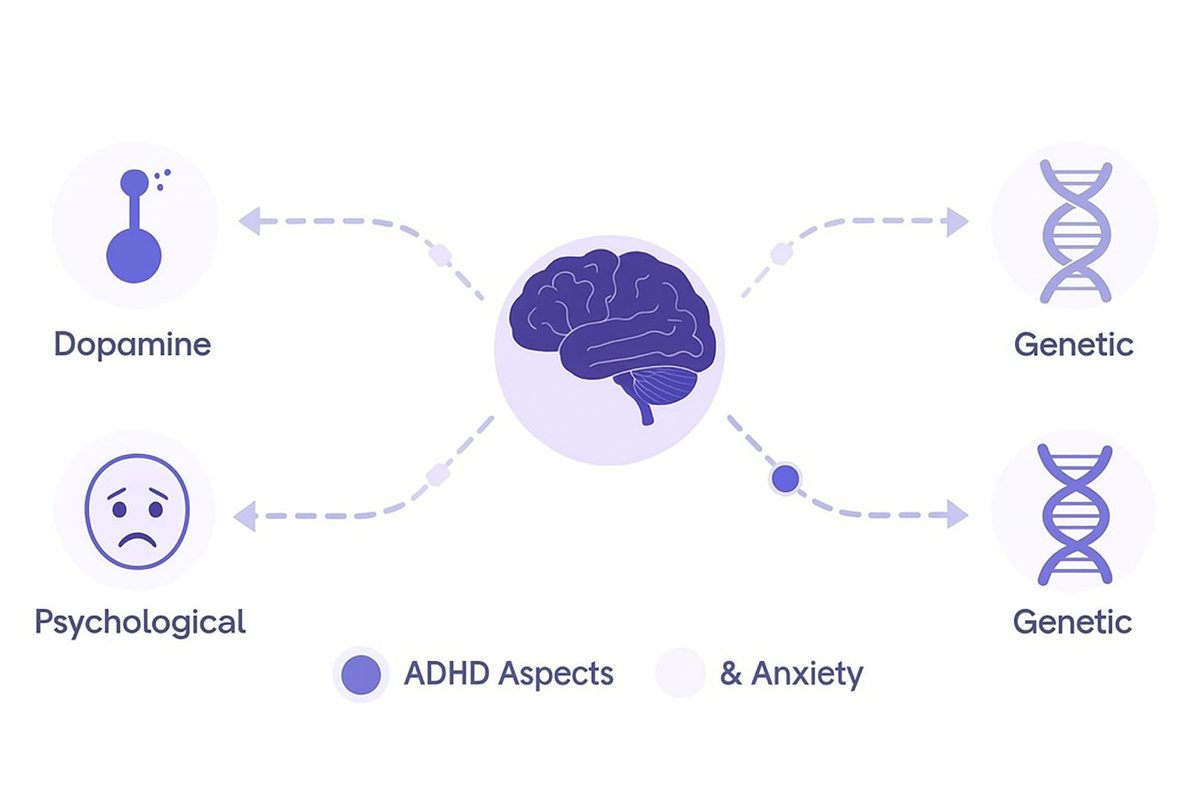
As you can see, this connection isn't just a coincidence. It’s a deep interplay between brain chemistry and life experiences. To really understand your own symptoms, you have to look past the what and start asking why.
The Core Difference: Why Am I Feeling This Way?
The real key to telling ADHD and anxiety apart is often the motivation behind the symptom. Is your mind wandering because you’re bored and seeking new stimulation (a common ADHD pattern)? Or has your focus been hijacked by a specific worry you just can't shake (a hallmark of anxiety)?
Let’s explore some common overlapping symptoms.
Difficulty Concentrating
- ADHD: Your mind drifts away from a task because it’s not engaging. It’s a pull toward something more interesting—a new idea, a notification, something outside the window.
- Anxiety: Your focus is being stolen by intrusive worries. It’s an inward pull, a mind stuck on a loop about a past mistake or a future threat, pushing the present moment away.
Restlessness & Fidgeting
- ADHD: This often feels like an internal engine that’s always running. It’s a physical need for movement to burn off energy or regulate focus, and it can be impulsive and automatic.
- Anxiety: This can feel like a physical symptom of internal tension. It might show up as jitteriness, muscle tightness, or an on-edge feeling, as if your body is bracing for something bad to happen.
Feeling Overwhelmed
- ADHD: This often stems from executive dysfunction. You might have too many tasks, can't prioritize, and don't know where to start, leading to a feeling of being paralyzed or "stuck."
- Anxiety: This can come from a sense of impending doom or a constant feeling that you can't cope with life's demands. It’s often driven by fear and a perceived lack of control over outcomes.
Understanding this distinction is everything. For example, when trying to figure out if physical discomfort is related to your mental state, it's helpful to know about things like chest pain as an anxiety symptom. The looping thoughts common in anxiety can be incredibly draining. Our guide on how ADHD and rumination offers five ways to stop overthinking can be a huge help here.
How ADHD Presents Differently in Women
The diagnostic puzzle can get even trickier when we talk about gender. For decades, the model for ADHD was based on hyperactive young boys, which left a huge blind spot. We now know that in women, ADHD often looks completely different.
Symptoms are frequently internalized. Instead of disruptive external behaviors, it can show up as inattentiveness, chronic disorganization, and a quiet, intense struggle with emotional regulation. This internal battle is easily mistaken—both by others and by women themselves—as just anxiety or a mood disorder.
Because the ADHD is less visible, the internal chaos it creates can go unaddressed. This constant feeling of "failing" to keep up, despite trying so hard, becomes the perfect breeding ground for an anxiety disorder. The anxiety is often a direct result of the unseen and unsupported ADHD.
Recognizing this pattern is power. When you can identify whether your restlessness is a need for stimulation or a state of worry, you're better equipped to talk to your doctor, advocate for yourself, and get the right diagnosis and support.
Finding the Right Treatment Path for Both
When you’re dealing with both ADHD and anxiety, you need a personalized game plan, not a one-size-fits-all solution. These two conditions are so tangled up that the best strategies are the ones that respect their unique relationship in your brain.
A thoughtful approach usually brings together a mix of medication, targeted therapy, and supportive lifestyle habits. The goal isn't just to manage symptoms, but to build a set of skills that helps you work with your brain, not constantly fight against it. Getting that combination right can build a foundation for long-term well-being.
Medication: A Careful Balancing Act
When it comes to treating co-occurring ADHD and anxiety, doctors often ask a key question: which one do we tackle first? For many people, the answer is to treat the ADHD.
The logic here is straightforward. If the chaos and stress from unmanaged ADHD are what’s fueling your anxiety, calming the ADHD can create a powerful domino effect. When stimulant medications help you focus and get a handle on your executive functions, that constant flood of late assignments and forgotten appointments starts to slow down. Less daily friction often means a natural drop in anxiety.
But it’s not always that simple. For some people, stimulant medications can ramp up feelings of jitteriness or physical anxiety. In those cases, it’s crucial to work closely with your doctor. They might need to tweak your dosage, switch you to a long-acting formula, or explore non-stimulant options that can manage ADHD symptoms without cranking up the anxiety.
The Power of Therapy, Adapted for Your Brain
Medication can be a game-changer for creating mental breathing room, but therapy is where you build the lasting skills to use that space well. For both conditions, Cognitive Behavioral Therapy (CBT) is a seriously effective approach.
CBT helps you spot, challenge, and reframe the unhelpful thought patterns that feed both anxiety and the negative self-talk that’s so common with ADHD.
💡 Insight: A core idea in CBT is that our thoughts, feelings, and behaviors are all connected. If you can learn to change your thought patterns—say, from "I'll never get this done, I'm a total failure" to "This is overwhelming, so I'll just start with one small piece"—you can directly change how you feel and what you do.
For the ADHD brain, CBT is often adapted to be more hands-on and structured. It focuses on practical strategies for tackling procrastination-fueled anxiety, managing time blindness, and breaking down huge, scary tasks into small, doable steps. If you want to dive deeper into how this works, you can learn more about how CBT for ADHD works in our detailed guide.
Building a Supportive Foundation
Beyond the doctor's office and therapy room, certain lifestyle habits can give your brain powerful support. These aren’t cures, but they are essential parts of a solid management plan.
This is especially critical for kids and teens. Data shows that about 40% of children with an ADHD diagnosis also have an anxiety disorder. This overlap can make emotional and behavioral challenges even tougher, which highlights the need for early, integrated support. You can discover more insights about these childhood statistics on ADDitude Magazine.
Think about adding these strategies into your routine:
- Regular Exercise: Getting your body moving is a proven way to boost dopamine and norepinephrine—the same brain chemicals targeted by some ADHD meds. It’s also a fantastic outlet for restless energy and a natural anxiety-buster.
- Mindfulness and Meditation: We get it, the idea of sitting still can sound like a nightmare for an ADHD brain. But mindfulness can be as simple as a three-minute breathing exercise or a mindful walk to help ground you in the present and quiet those racing thoughts.
- Nutrition and Sleep: A balanced diet and consistent sleep are the bedrock of emotional regulation and focus. They give your brain the stability it needs to handle the daily demands of both conditions.
Putting together a comprehensive plan with a professional is a journey of self-discovery. This is exactly the kind of skill-building that Inflow's clinician-developed programs are designed to support, offering accessible, CBT-based modules that turn these strategies into daily practice.
ADHD-Friendly Strategies for a Calmer Day
Moving from understanding to action—that's where the real change happens. Knowing why ADHD and anxiety are so tangled up is powerful, but having a toolkit of strategies you can actually use right now is a game-changer. These techniques are designed to work with your brain, helping to smooth out the daily friction and build a stronger sense of calm and control.
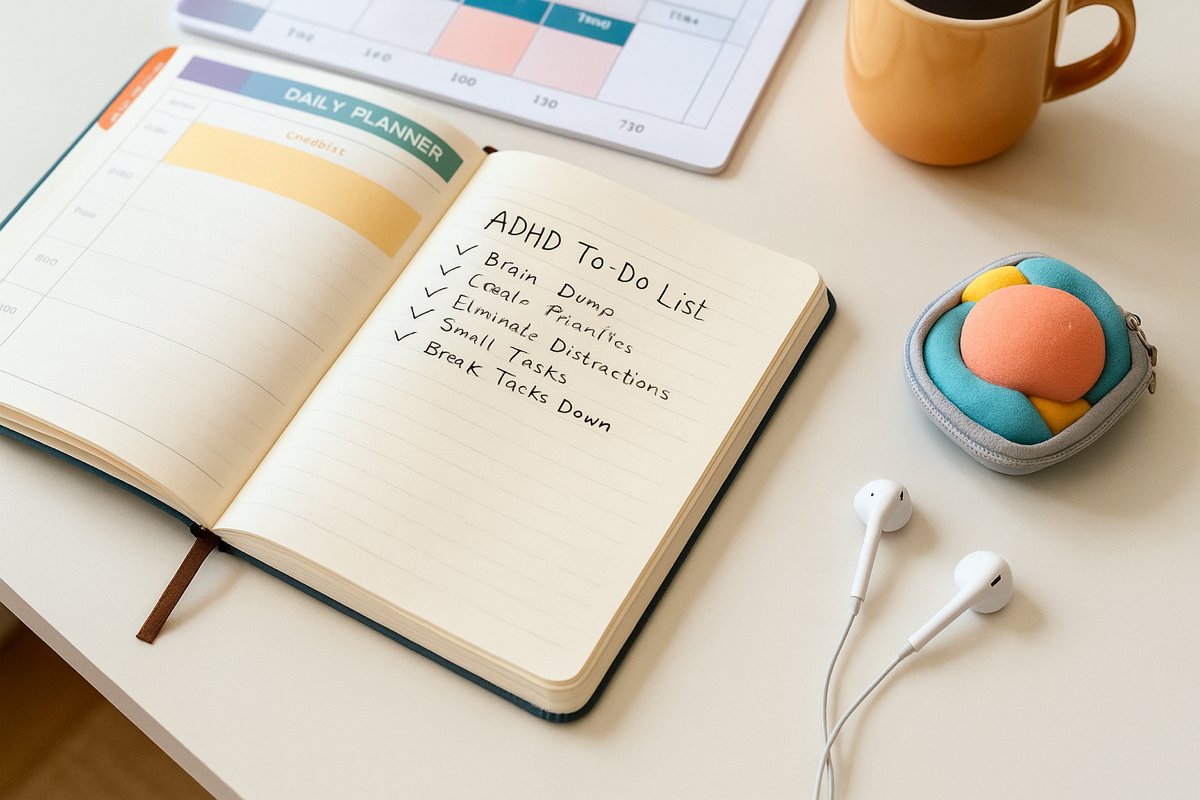
These strategies don't require a massive dose of willpower or executive function to get started. They're small, concrete actions that can offer immediate relief and build momentum for bigger shifts down the road.
Clear Your Mental Cache with a Brain Dump
If your mind feels like a browser with a hundred tabs open, a brain dump is your force-quit button. The technique is simple: take every single thought, worry, and to-do item swirling around in your head and get it out onto paper.
The goal isn't to create a perfectly organized list. It’s about externalizing the chaos to instantly lower your cognitive load. By writing it all down, you're telling your brain it no longer needs to hold onto everything, which can quiet the internal chatter and free up mental bandwidth.
Tame Overwhelm with Time Blocking
That giant, terrifying project on your to-do list? It’s a major source of procrastination anxiety. Time blocking is the perfect antidote, breaking that monster down into tiny, non-threatening pieces. Instead of writing "Work on presentation," you block out a specific, manageable chunk of time, like "Tuesday, 10:00-10:25 AM: Brainstorm three main points for slide 1."
This works because it shifts your focus from the overwhelming final product to a single, achievable action. It answers the critical question, "What do I do right now?"—a powerful defense against the paralysis that both ADHD and anxiety can trigger.
Create Transition Rituals to Ease Gear Shifts
For the ADHD brain, switching from one task to another can be a major point of friction, often setting off that panicky "what's next?!" feeling. A transition ritual is a small, predictable routine that acts as a buffer between activities.
💡 Insight: Think of it like a clutch in a car. It allows your brain to disengage from one gear before smoothly shifting into the next, preventing a jarring mental grind.
Your ritual can be anything that signals a change is coming.
- Stand up and stretch for 60 seconds.
- Refill your water bottle and walk around the room.
- Listen to one specific song.
This simple practice gives your brain a moment to reset, making the shift to a new task feel less abrupt and overwhelming.
Mindfulness for an Active Mind
Let's be real: traditional meditation can feel impossible when your mind is always on the go. The good news is that mindfulness doesn't have to mean sitting still in silence. For an ADHD-anxiety brain, it’s about finding small moments to ground yourself in the present.
Integrating simple yet powerful breathing techniques for relaxation can have a huge impact on your sense of calm and focus. Mindful movement, like a short walk where you just pay attention to the feeling of your feet on the ground, can also be incredibly effective. Our guide to calming activities for ADHD has even more ideas designed for an active mind.
Build Your Sensory Toolkit
Sensory overstimulation can be a massive trigger for emotional overwhelm and anxiety. Having a "sensory toolkit" ready to go can help you manage your environment before it manages you.
✅ Checklist for Your Sensory Toolkit:
- Noise-canceling headphones: To create an instant bubble of quiet.
- Fidget tools: A stress ball or spinner to channel restless energy.
- Weighted lap pad or blanket: Provides calming deep-pressure stimulation.
- Scented lotion or essential oil: A pleasant smell can ground you in the moment.
- Sunglasses: To reduce harsh lighting that can feel jarring.
Turning these strategies into sustainable habits takes practice. This is where the Inflow app can be a great ally, offering bite-sized modules and daily reminders that help you weave these tools into your life, one calm moment at a time.
Your Path to Finding Calm and Focus
The road with ADHD and anxiety can feel like an uphill battle, but it's one you can absolutely navigate. The whole point of this guide was to arm you with your most powerful tool: self-understanding.
When you start recognizing your patterns, knowing your triggers, and having a few go-to strategies in your back pocket, you're laying the foundation for a calmer, more focused life. If you're just now connecting these dots for yourself, please know you're in very good company.
You Are Not Alone
It's easy to feel isolated in this struggle, but the numbers tell a different story. Recent research estimates that adult ADHD affects about 3.1% of people worldwide, a figure drawn from a massive meta-analysis of over 21 million people.
That rate puts it on par with other major conditions like major depressive disorder, underscoring just how significant ADHD is as a public health issue—especially when it's tangled up with anxiety. You can dig deeper into these global adult ADHD prevalence findings if you're curious.
Remember to approach this whole process with a heavy dose of self-compassion. This journey is about growth and learning to work with your unique brain, not about trying to 'fix' a part of you that isn't broken.
As you move forward, keep seeking out resources that click with your personal experience. You're essentially learning a new skill—the skill of navigating your own mind with awareness and kindness.
Ready to take another step on your path to clarity? Explore the structured, science-backed support in the Inflow app. You can also take the Inflow quiz to get a clearer picture of your own experience with ADHD.
You have the power to build a life that feels less chaotic and more like you. It all starts with this one crucial step: understanding what's going on inside.
Your Questions, Answered
Navigating the worlds of ADHD and anxiety can feel like trying to solve a puzzle with pieces from two different boxes. It naturally brings up a lot of questions. Getting clear, straightforward answers is a huge part of feeling more in control, so let’s tackle some of the most common ones we hear.
Can treating my ADHD make my anxiety worse?
This is a valid concern. For most people, treating ADHD with stimulant medication actually significantly reduces anxiety. When your executive functions start working better, the daily chaos that fuels so much stress—the missed deadlines, the lost keys—begins to fade. When your life is less chaotic, there’s simply less to be anxious about.
However, a small number of people do find that stimulants can dial up feelings of jitteriness or physical tension. This is why it’s so critical to work closely with a healthcare provider. They can monitor your symptoms, adjust your dosage, or explore non-stimulant medication options if needed. Open communication with your doctor is everything.
Should I treat the ADHD or the anxiety first?
Many clinicians follow a simple principle: treat the "primary" condition first. When it comes to co-occurring ADHD and anxiety, ADHD is often the one pulling the strings. The anxiety is frequently a secondary, reactive condition—the logical emotional fallout from the daily struggles of having ADHD.
In these cases, getting the ADHD treatment right often leads to a natural—and powerful—reduction in anxiety symptoms. That said, a thorough diagnostic evaluation is key to figuring out the specific dynamic between your symptoms. Your provider will work with you to create a personalized plan.
How is an anxiety attack different from an ADHD outburst?
This can be incredibly confusing from the inside because both involve a massive flood of intense emotion. The real difference usually comes down to the trigger and the duration.
- An ADHD emotional outburst, which can be tied to challenges with emotional regulation or Rejection Sensitive Dysphoria (RSD), is typically a sudden, intense, but short-lived reaction. It’s a flash flood sparked by a specific, immediate trigger, like perceived criticism. Once that trigger is gone, the intense emotion can often disappear just as quickly as it arrived.
- In contrast, a panic or anxiety attack can feel like it comes completely "out of the blue," or it might be triggered by a spiral of internal worries. It often brings on powerful physical symptoms like a racing heart, shortness of breath, and a profound sense of impending doom that can linger long after the initial wave of panic has passed.


